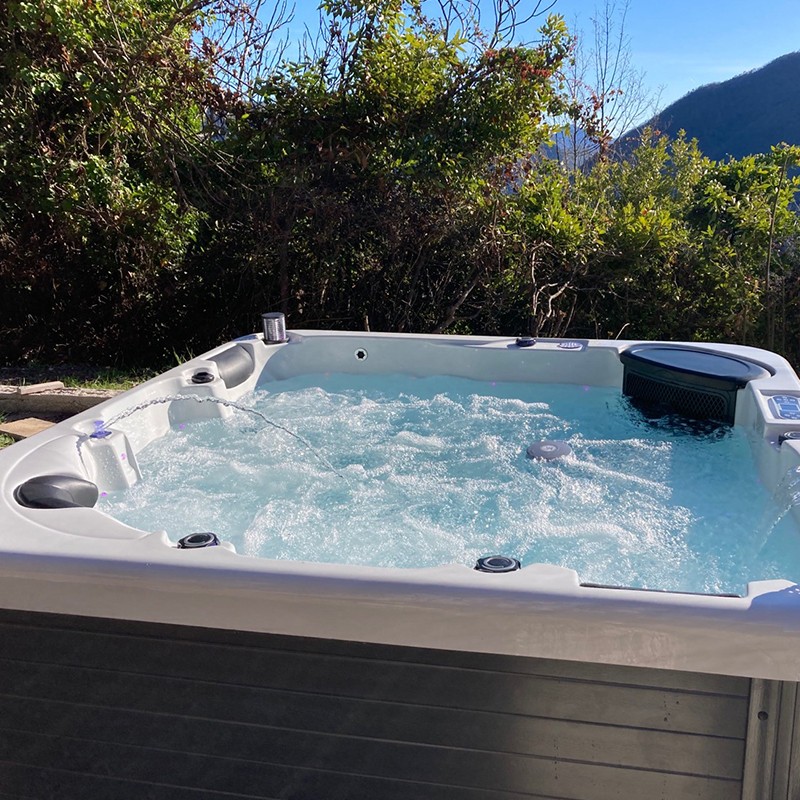
How long is it safe to stay in a 104°F (40°C) hot tub?
2024-10-09 15:30Hot tubs are loved by many people for their relaxing, stress-relieving, and muscle-soothing effects. However, soaking in a 104°F (40°C) hot water tub for too long may have adverse effects on the body.
So, how long is it safe to stay in such a hot bathtub? This article will explore this question in detail from the aspects of physiological reactions, potential risks, and practical suggestions.

Human body physiological reactions to hot environments
Thermoregulation mechanism
The human body regulates its body temperature through sweat evaporation and blood circulation. When the outside temperature is too high, the body dissipates heat by dilating blood vessels and increasing sweat secretion. The high temperature environment in a hot water tub increases the body's heat dissipation burden, and prolonged soaking may cause the body's thermoregulation mechanism to be unbalanced.
Cardiovascular system reaction
The hot environment causes blood vessels to dilate, increasing blood flow and heart burden. Heart rate and blood pressure may fluctuate in high temperatures. For people with poor cardiovascular health, soaking in high temperatures for a long time may cause heart discomfort or other cardiovascular problems.
Dehydration and electrolyte imbalance
High temperatures can cause the body to sweat profusely, leading to fluid loss. If you don't replenish your body water in time, you may suffer from dehydration and electrolyte imbalance. Dehydration can affect the normal functioning of various systems in the body, causing dizziness, fatigue, and other discomfort symptoms.

Potential risks of soaking in a hot tub for a long time
Heat stroke
Heat stroke is one of the common risks in hot environments. Soaking in a hot tub at 104°F (40°C) for a long time may cause the body temperature to rise too high, causing heat stroke. Symptoms of heat stroke include dizziness, headache, nausea, vomiting, and confusion, which can be life-threatening in severe cases.
Skin damage
High temperature water environments can affect the skin's barrier function, causing dry and sensitive skin. Soaking in hot water for a long time may damage the skin's natural oil barrier, causing problems such as dry skin, itching, and peeling. In addition, high temperatures may also cause skin burns and redness.
Cardiovascular events
As mentioned earlier, high temperatures increase the workload on the heart, causing fluctuations in heart rate and blood pressure. For patients with cardiovascular diseases such as high blood pressure and heart disease, soaking in a hot bathtub for a long time may induce a heart attack or other serious cardiovascular events.
Respiratory problems
The steam and humidity in a hot environment may affect the respiratory system. Soaking in a hot tub for a long time may cause shortness of breath, difficulty breathing and other problems, especially for patients with asthma or other respiratory diseases.
How long is it safe to stay in a 104°F (40°C) hot tub?
According to various studies and health guidelines, soaking in a 104°F (40°C) hot tub should be controlled within 10 to 15 minutes to ensure safety. The following are specific time recommendations:
Generally healthy people
For people who are in good health and have no obvious health problems, it is recommended to soak in a 104°F (40°C) hot tub for 10 to 15 minutes. This time is enough to enjoy the relaxing and soothing effects of a hot water tub while avoiding the adverse effects of soaking for a long time.
Cardiovascular disease patients
For people with cardiovascular disease, it is recommended to soak in a hot water tub for no more than 10 minutes. And it is best to consult a doctor before use to ensure safety.
Elderly and children
Elderly and children have relatively weak body temperature regulation ability, and it is recommended not to soak in a high-temperature hot tub for more than 5 to 10 minutes. Especially for children, their skin is delicate, and long soaking may cause skin problems.
Pregnant women
Pregnant women need to be particularly cautious when using hot bathtubs, and high temperature environments may have adverse effects on the fetus. It is recommended that pregnant women avoid soaking in a hot tub at 104°F (40°C). If you need to use it, you should control the time to within 5 to 10 minutes and consult a doctor.

What are the precautions for using a hot tub?
Control the water temperature
When using a hot tub, make sure the water temperature is controlled within a safe range. 104°F (40°C) is a high water temperature, and it is not recommended to exceed this temperature. You can use a thermometer to check the water temperature to ensure that it is within a safe range.
Timed reminder
When soaking in a hot tub, you can set a timer to remind yourself not to soak for too long. This can avoid ignoring time due to excessive relaxation and causing physical discomfort.
Stay hydrated
Before and after using a hot bathtub, you should drink plenty of water to stay hydrated. This will help prevent dehydration and electrolyte imbalances caused by excessive sweating.
Avoid alcohol and medications
Avoid alcohol and certain medications before using a hot tub, as they may affect temperature regulation and cardiovascular function, increasing your risk.
Enter and exit gradually
When entering and exiting a hot water tub, you should do so slowly to avoid dizziness and discomfort caused by temperature changes. This is especially true for the elderly and those with cardiovascular disease.
In summary, soaking in a hot bathtub at 104°F (40°C) can have a relaxing and soothing effect, but it needs to be timed to ensure safety. The average healthy person should soak for 10 to 15 minutes at this temperature, while those with cardiovascular disease, the elderly, children, and pregnant women should soak for a shorter period of time.
